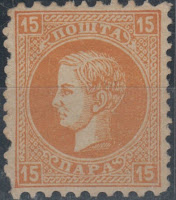Milan Obrenović (22 August 1854 – 11 February 1901) was the ruler of Serbia from 1868 to 1889, first as prince (1868-1882), subsequently as king (1882-1889).
Milan Obrenović was born in 1854 in Mărășești, Moldavia where his family lived in exile ever since the 1842 return of the rival House of Karađorđević to the Serbian throne when they managed to depose Milan's cousin Prince Mihailo Obrenović III.
Milan was the son of Miloš Obrenović (1829–1861) and his Moldavian wife Marija Obrenović (née Elena Maria Catargiu). Milan's paternal grandfather (Miloš's father) was Jevrem Obrenović (1790–1856), brother of Miloš Obrenović I, Prince of Serbia. Milan was therefore Prince Miloš's grandnephew. He had only one sibling — sister Tomanija.
Shortly after Milan's birth, his parents divorced. Several years later on 20 November 1861, at the age of seven, Milan's father Miloš died fighting the Turks near Bucharest as a foreign mercenary in the Romanian Army, meaning that his mother Marija got a legal custody. Marija, however, lived a lavish aristocratic lifestyle, soon becoming Romanian ruler Alexandru Ioan Cuza's mistress and bearing him two sons — Alexandru Al. Ioan Cuza (nicknamed Sașa) and Dimitrie. As a result, she showed little interest in her children from the previous marriage with Miloš. Therefore, an agreement was reached for young Milan to get legally adopted by his cousin Mihailo Obrenović. who in the meantime, following the 1858 expulsion of the Karađorđevićs, had returned to Serbia where he became the ruling prince in 1860.
On 10 June 1868, when Milan was only fourteen years of age, Prince Mihailo Obrenović III was assassinated. As the late prince did not have any male heirs, the question of who was to succeed him on the Serbian throne became a pressing one. In the post-assassination chaos and the resulting power vacuum, influential senior statesman Ilija Garašanin re-emerged in Serbian political life, despite only eight months earlier being removed by the late prince from the post of Prime Minister of Serbia and replaced with Jovan Ristić. While consolidating forces within the state to prevent the conspirators from taking over the power, Garašanin also reportedly contemplated solving the throne issue by starting a third royal dynasty. General political consensus was that the new ruler should be selected by the Visoka narodna skupština (Grand National Council). However, cabinet minister Milivoje Petrović Blaznavac was rapidly increasing his power and influence. He had managed to consolidate his control over the army and stage a coup d'état. So when Blaznavac suggested the young Milan as the successor to Prince Mihailo, Garašanin had no choice but to yield to the more powerful authority.
On 22 August 1872, Milan was declared of age, and he took government into his own hands. He soon demonstrated great intellectual capacity, coupled with a passionate headstrong character. Eugene Schuyler, who observed him about this time, found him to be a very remarkable, singularly intelligent and well-informed young man. The Principality of Serbia was still a de jure part of the Ottoman Empire though in reality it already had long functioned as a semi-independent state whose politics and economy was much more dependent on other Great Powers, particularly Austria-Hungary and Russian Empire, than on its formal ruler, the declining Ottomans. Milan carefully manoeuvred between the Austrian and Russian geopolitical interests in Serbia, with a judicious leaning towards the former.
On 3 January 1889, Milan adopted a new constitution much more liberal than the existing one of 1869. Two months later, on 6 March, thirty-four-year-old Milan suddenly abdicated the throne, handing it over to his twelve-year-old son. No satisfactory reason was assigned for this step. Milan settled in Paris as a private individual.






